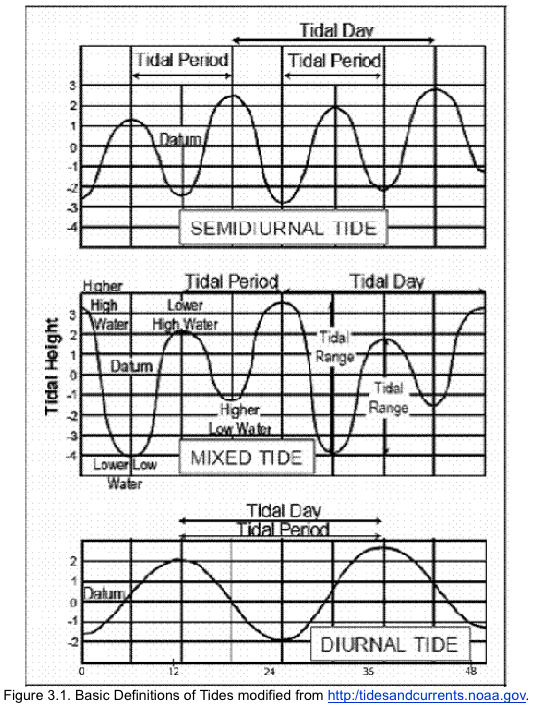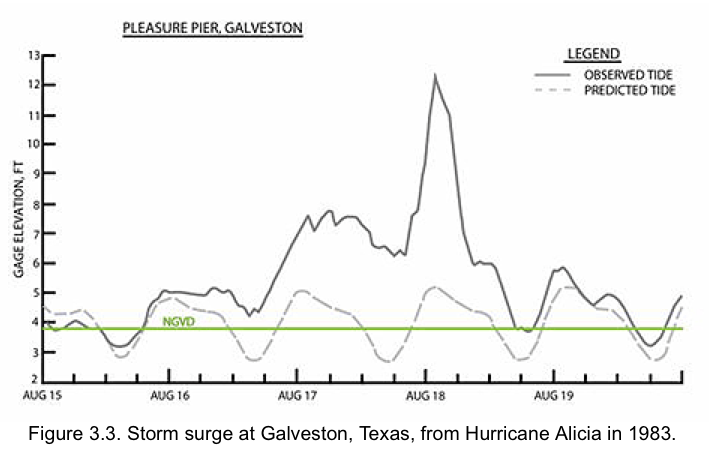FEDERAL HIGHWAY ADMINISTRATION
Chapter 3 – Tides, Storm Surge and Water Levels
Water level fluctuations include astronomical tides, storm surges, and long-term sea level rise or fall. Water level is important in coastal processes and engineering in part because it controls the location of wave influence on shorelines and structures. Geologically, sea level controls the overall location and shape of the continental shoreline. The definitions of tidal datums and surveying datums can be important for the design of engineering works near the coast. Storm surge, which temporarily raises the water level, can control the design water level for engineering. Tidal currents can be significant as tides and storm surges enter and exit coastal bays through inlets.
The portion of the water level fluctuation controlled by the astronomical bodies, the moon and the sun, are referred to as the astronomical tide. Additionally, coastal water levels are often affected by meteorological conditions including storm surge in response to winds and waves and local rainfall.
3.1 Astronomical Tides
The tide is the slow rise and fall of the ocean waters in response to the gravitational pull of the moon and the sun. The tide is essentially a very long ocean wave with a wave period of 12.4 hours. The usual interval between successive high tides is 12.4 hours as the arrival of the crests of these waves represent high tide. The moon exerts a greater influence on the tides than does the sun.
The astronomical tide is well understood and can be predicted for any time at many locations. Tidal predictions are well understood by most coastal residents and are often included in local daily newspapers and weather forecasts. NOAA’s National Ocean Survey provides on-line tidal forecasts as well as other information about tides around the nation.2 Along most coasts bordered by the ocean, the astronomical tide forecasts are within 1 ft of the actual tide elevation 90% of the time. The difference between the forecasts and actual water elevation measurements is normally a result of weather related phenomena (e.g., wind blowing from same direction over some period, i.e. a storm surge). Understanding some of the characteristics of tides is helpful in understanding some of the terminology used to define tides and tidal datums.
3.1.1 Characteristics of Astronomical Tides
In most locations in the United States, there are two high tides and two low tides every lunar day (24.8 hours). These are called “semidiurnal” tides (see Figure 3.1). At many locations the two high tides that occur each day are roughly of the same elevation. But at many other locations, there is a “mixed tide” with a clear “diurnal inequality” in the high tides as one is significantly higher than the other. Some places, like portions of the Gulf of Mexico, have only one high tide and one low tide per day. These tides are called “diurnal” tides. 
Large differences in tide range occur at the same location throughout the month. The highest tides which occur at intervals of half a lunar month are called “spring tides.” They occur at or near the time when the moon is new or full, i.e., when the sun, moon and earth fall in-line, and the tide generation forces of the moon and sun are additive. When the tide range is at its lowest during the lunar month, the “neap tides” occur.
Large differences in the magnitude of the daily tide range occur at different locations in the US. These differences are caused by the interactions of the oceanic tidal motions with the continental land mass and the depths and shape of coastal bays and shelves. At Anchorage, Alaska, the tide range can vary up to almost 30 feet between high and low tide. At Pensacola, Florida, however the range can be less than 2 feet throughout a day. These differences in tidal range can occur within short distances along the coast and up bays. For example, the average tide range at Sandy Hook, New Jersey is about 5 feet but is only 2 feet just 125 miles away at Montauk Point, New York.
The basic astronomical tide producing forces go through a “tidal epoch,” a cycle that lasts approximately 18.6 years. Thus, water level statistics related to tides, such as mean sea level, are computed by averaging over a complete epoch.
…
3.2 Storm Surge
Storm surge is the rise of water level above the astronomical tide as a result of meteorological forcing. This forcing is primarily wind but also includes the barometric pressure and, for some coastal locations, local rainfall runoff. Storm surge can be negative, i.e. winds can decrease water levels from the astronomical tide levels. Storm surge is highly influenced by geography including the shape of the coast and its bays, the nearshore bathymetry, and the flooded topography. High storm surges occur along the coast where the landmass stops the hydrodynamic movements. The highest storm surge can occur in bays. Wind affects storm surge by placing a stress on the water surface, by generating oceanic currents and by generating waves. Breaking waves can contribute to storm surge by adding a component of mean water surface elevation called wave setup. Storm surge is an important coastal process for the design of coastal infrastructure primarily because it increases the design still water level and allows waves to attack higher elevations. Surge also can be an important component in tidal inlet hydrodynamics.
Figure 3.3 is an example of hurricane storm surge. The predicted tide is plotted along with measurements from a tide gage located on a pier in the Gulf of Mexico. The surge, the difference between the predicted and actual water level, extends for several days with a very dramatic peak of over 7 feet above the predicted high tide early on August 18. That high peak corresponds with the time that the hurricane made landfall with its eye just to the southwest of the tide gage.
The hydrograph of a coastal storm surge is usually considered as the time variation of water surface elevation at a specific location. Both the magnitude and duration of a coastal storm surge can be important. During the most destructive coastal storm in United States history, Hurricane Katrina in 2005, the water level rose 27 feet higher than its predicted tide elevation due to storm surge along much of the coast near Bay St. Louis, Mississippi. Several inland locations had mean high water marks over 30 feet in elevation. This storm surge was unprecedented in United States history. But the previous high storm surge, 21 feet, was along this same stretch of coast in Hurricane Camille of 1969. Another of the most destructive storms in American history, the Nor’easter Ash Wednesday Storm of 1962, caused much of its damage due to its relatively long duration. The storm surge lasted for 2½ days over five semi-diurnal high tides, or “five high-tides.” This long duration allowed beach storm erosional processes to act that long and cause extensive property damage along the Atlantic coast.
Read full report (PDF) here: Highways in the Coastal Environment
About The Federal Highway Administration (FHWA)
www.fhwa.dot.gov
“The Federal Highway Administration (FHWA) is an agency within the U.S. Department of Transportation that supports State and local governments in the design, construction, and maintenance of the Nation’s highway system (Federal Aid Highway Program) and various federally and tribal owned lands (Federal Lands Highway Program). Through financial and technical assistance to State and local governments, the Federal Highway Administration is responsible for ensuring that America’s roads and highways continue to be among the safest and most technologically sound in the world.”
Tags: Federal Highway Administration, FHWA, Hurricane Sandy, Storm Surge, Tides, Water Levels






 RSS Feed
RSS Feed